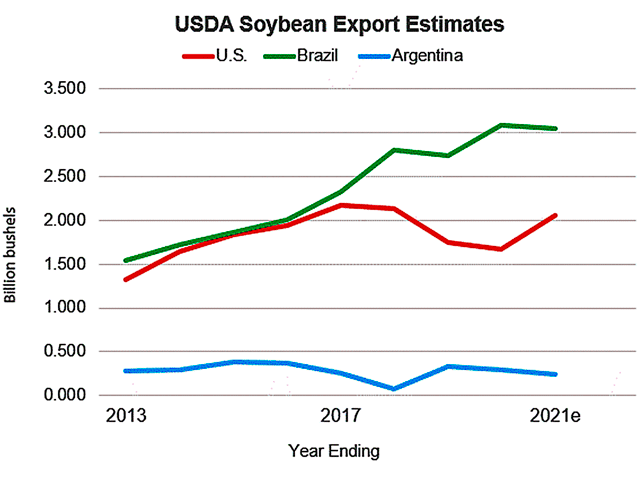Todd's Take
Constipated Ag Markets
This week's big news was USDA's explanation of how it would distribute funds to farmers through its Coronavirus Food Assistance Program (CFAP). I won't rehash it here, but the short story is that applications will be available at the Farm Service Agency on May 26. Producers should quickly participate to help cover some of the losses on 2019 production (see more at https://www.farmers.gov/…).
Wheat markets surprised us with double-digit gains Wednesday as weather concerns in the U.S. and Europe start to carry more weight. I talked about spring wheat's bullish potential two weeks ago in this space (https://www.dtnpf.com/…) and Wednesday's rally could spark more short-covering with funds sitting on record-large bearish bets.
Wednesday's higher close in July KC wheat didn't change the downtrend I mentioned last week. If adverse weather continues to worsen, the winter wheat market could get a lot more interesting.
Looking at row crops, there hasn't been much new of late. Corn demand remains bogged down by people not driving and slaughter plants operating at lower capacity. USDA's estimate of Brazil's corn crop remains near the record high of 3.98 billion bushels (bb) (101.0 mt).
Soybean demand could see some benefit from the loss of competing distillers grains in 2020. Overall, however, a slower slaughter pace resulting in the destruction of hogs and poultry has not been good news for meal demand. July soybean meal fell to a new contract low Thursday (May 21).
In addition to feed demand concerns, the trade dispute with China is as contentious as ever. President Donald Trump has threatened new tariffs on China if it doesn't start increasing U.S. ag purchases. On Tuesday, May 19, the president offered a more drastic alternative. FoxNews.com quoted the president as saying, "We could cut off the whole relationship."
An email from USDA on Thursday, May 21, sought to soften the tone, assuring us that progress was being made in implementing the phase-one agreement. U.S. Trade Representative Robert Lighthizer concluded, "Under President Trump's leadership, we fully expect this agreement to be a success." July soybeans finished the day down 11 3/4 cents.
P[L1] D[0x0] M[300x250] OOP[F] ADUNIT[] T[]
Markets in 2020 are suffering a chronic case of constipation. U.S. soybean supplies are backed up without access to the world's largest buyer of soybeans. Reluctant to plant soybeans, the early intention of farmers was to plant more corn in 2020 until coronavirus interrupted those plans.
As people stayed home, ethanol production dropped and inventory swelled to record highs. Saudi Arabia increased crude oil production and U.S. oil supplies quickly taxed storage capacity. Coronavirus concerns shut down slaughter plants, causing livestock and poultry supplies to quickly reach unmanageable levels. Milk was poured on the ground as distribution channels shut down.
Everywhere we turned, the tremendous productive capacity of U.S. agriculture was being wasted, clogged in constipated channels of demand. To date, coronavirus concerns are slowly easing, but the threat of infection remains serious.
Now, 97.0 million acres of corn planting intentions are apt to become 94.0 million actual acres. Ethanol inventory has fallen back to pre-coronavirus levels. Crude oil inventory was down 5.0 million barrels last week, a small step in a more balanced direction.
Hog slaughter is back near 400,000 head per day, higher than it was, but still down 15% from a year ago. Class III milk prices have recovered from less than $11 in April to $17.62 on Thursday's close.
Improvements from an easing coronavirus threat appear to be happening slowly and presumably will take time. Other than finding a vaccine or treatment and people getting back to work, there is little more we can do to push things along.
The trade dispute with China, however, is a difficult choice worth reconsidering. It is not clear yet if the result will be worth the enormous cost. On May 12, USDA estimated Brazil's soybean exports will outpace the U.S. by 1.0 bb in 2020-21, the third consecutive annual gap of that size. That is a lot of business being left on the table.
Unless Brazil suffers adverse weather early next year, the export gap will likely be more than 1.0 bb in 2020-21. USDA's 2.05 bb estimate of U.S. exports in 2020-21 is highly unlikely without China's cooperation. To date, China has shown no sign of succumbing to whatever pressures tariffs are exerting. The commercial consideration clause in the phase-one agreement is a good example of how China refuses to bind itself to any solid purchase commitments.
The larger tragedy is that, among the big three U.S. crops, soybeans has been the clear leader in terms of world demand growth for decades. Even as China lost hogs to African swine fever, world soybean demand continued to rise to new record highs. USDA expects another year of record demand in 2020-21, nearly 4% higher than the current season.
Instead of being an unnecessary source of demand constipation, the world's growing soybean market offers U.S. producers the best chance for increased profitability and could ease the bearish strain on other crops.
I don't know how to stop China from stealing high-tech secrets, but I do understand why many economists don't favor higher tariffs. Surely there's a better way to get the U.S. back in the business of selling soybeans again.
After seeing the ag economy hit by the coronavirus, I am thankful for our farmers that CFAP is going to provide some welcome relief. I wish, for all our sakes, we could also find a way to open international trade for soybeans again.
Todd Hultman can be reached at Todd.Hultman@dtn.com
Follow him on Twitter @ToddHultman
(c) Copyright 2020 DTN, LLC. All rights reserved.



